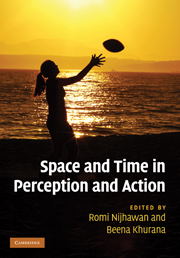Book contents
- Frontmatter
- Contents
- List of contributors
- Acknowledgments
- 1 Space and time: the fabric of thought and reality
- Part I Time–space during action: perisaccadic mislocalization and reaching
- 2 The internal eye position signal, psychophysics, and neurobiology
- 3 Factors influencing perisaccadic visual mislocalization
- 4 Visual and nonvisual factors in perisaccadic compression of space
- 5 Keeping vision stable: rapid updating of spatiotopic receptive fields may cause relativistic-like effects
- 6 Combined influences of extraretinal signals, retinal signals, and visual induction on space perception and manual behavior in perisaccadic and steady viewing
- 7 Space constancy: the rise and fall of perceptual compensation
- 8 Intercepting moving objects: do eye movements matter?
- 9 The utility of visual motion for goal-directed reaching
- Part II Temporal phenomena: perception
- Part III Temporal phenomena: binding and asynchrony
- Part IV Spatial phenomena: forward shift effects
- Part V Space–time and awareness
- Index
- References
6 - Combined influences of extraretinal signals, retinal signals, and visual induction on space perception and manual behavior in perisaccadic and steady viewing
from Part I - Time–space during action: perisaccadic mislocalization and reaching
Published online by Cambridge University Press: 05 October 2010
- Frontmatter
- Contents
- List of contributors
- Acknowledgments
- 1 Space and time: the fabric of thought and reality
- Part I Time–space during action: perisaccadic mislocalization and reaching
- 2 The internal eye position signal, psychophysics, and neurobiology
- 3 Factors influencing perisaccadic visual mislocalization
- 4 Visual and nonvisual factors in perisaccadic compression of space
- 5 Keeping vision stable: rapid updating of spatiotopic receptive fields may cause relativistic-like effects
- 6 Combined influences of extraretinal signals, retinal signals, and visual induction on space perception and manual behavior in perisaccadic and steady viewing
- 7 Space constancy: the rise and fall of perceptual compensation
- 8 Intercepting moving objects: do eye movements matter?
- 9 The utility of visual motion for goal-directed reaching
- Part II Temporal phenomena: perception
- Part III Temporal phenomena: binding and asynchrony
- Part IV Spatial phenomena: forward shift effects
- Part V Space–time and awareness
- Index
- References
Summary
Summary
The locations of stationary objects appear invariant, although saccadic eye movements shift the images of physically stationary objects on the retina. Two features of this perceptual stability related to saccades are that postsaccadic locations of objects appear invariant relative to their appearance in the presaccadic view, and perception of postsaccadic stimulation is free from interference by remnants of presaccadic stimulation. To generate stability, quantitatively accurate cancellation between retinal input (RI) and extraretinal eye position information (EEPI) must occur, and persisting influences from the presaccadic view must be eliminated. We describe experiments with briefly flashed visual stimuli that have measured (1) the time course of perisaccadic spatial localization, (2) the interfering effects of persisting stimulation prior to the postsaccadic period, (3) the achievement of perceptual stability by removing visual persistence early, and (4) the influence of metacontrast utilizing the normal perisaccadic spatiotemporal distribution of retinal input to prevent interference from visual persistence.
For the steady eye, a generalized cancellation mechanism is analyzed through studying mislocalizations in perceptual orientation and visually guided manual behavior produced by (1) modifying EEPI in observers with experimental partial paralysis (curare) of the extraocular muscles and/or (2) modifying RI by varying visual field orientation (i.e., its pitch and/or roll). The influences of visual pitch and roll derive from the retinal orientations of individual straight lines and their combinations, with the identical lines influencing perceived verticality and elevation. […]
Information
- Type
- Chapter
- Information
- Space and Time in Perception and Action , pp. 63 - 93Publisher: Cambridge University PressPrint publication year: 2010
References
Accessibility standard: Unknown
- 2
- Cited by
